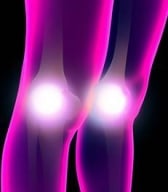When Two Joint Replacements
are Better than One
Medically Reviewed by Michael J. Sutton, DO
Not only was Darth Vader the father of Luke Skywalker in Star Wars, but all that light saber fighting took its toll. Darth – in real life, actor Dave Prowse – needed a Hip Replacement. And not just one hip – but both.
Like many people (even those who don’t fight with light sabers) Vader (AKA Prowse) had to decide whether to have BOTH hip joints replaced in one surgery…or first have one hip replaced, recover, then have the second replaced, also called staged replacement. He decided on doing both at the same time, also called bilateral joint replacement.
“There are three primary issues that lead to bilateral joint replacement,” says McLeod Orthopedic Surgeon Dr. Michael Sutton of McLeod Orthopaedics Dillon. “First, are BOTH of your knees or hips giving you problems? Second, do you WANT to have both done at the same time. And third, what does your orthopedic SURGEON recommend.”
Here are some of the considerations that went into Vader’s/Prowse’s decision…and, if you face the same issue with hip or total knee joint replacement, may go into yours.
GENERAL ISSUES
Simultaneous replacement is not for everyone, especially for 1) people over 80 years of age or 2) people with heart problems or 3) people with lung disease.
THE SURGERY
If both hips or knee joints need replacement, the overall risks of bilateral replacement must be compared to having two separate surgeries. In this light – one surgery is better than two: 1) Less overall time in the hospital, 2) under anesthesia only once, 3) less time in the operating room, 4) less overall time in rehab.
Several studies have looked at complications comparing the bilateral (both) versus staged (one at a time) approach to joint replacement. Replacing both joints at the same time results in:
- Lower risk of major mechanical malfunction.
- Fewer prosthetic joint infections.
- Lower risk of a need for revision surgery to replace the joint due to problems unrelated to infection.
- Similar risk of death and stroke, compared to staged repair.
- Slightly increased risk of blood clots or heart attack. However, these complications are very rare.
The author of one recent study flatly stated, “The findings indicate that performing simultaneous replacements would significantly reduce the incidence of major orthopedic complications.”
RECOVERY/REHAB
Patients with both joints replaced in the same surgery may be walking around on crutches in a few days.
Yet, most people who have BOTH knees or hips replaced at the same time should plan to spend some time in an inpatient rehabilitation unit or hospital. Depending on the type of job you have, plan on about 6-8 weeks off work.
The rehabilitation is hard work, whether one knee/hip or two. If there are two separate surgeries, that results in two separate rehab programs. Plus, if both your knee or hip joints are bad, when you are going through the first rehab, you’ll be hampered by the remaining bad knee or hip.
FINAL THOUGHT
A bilateral – two hip or knee joints at one time – surgery is a reasonable option for most people. Any decision must be made in consultation with your orthopedic surgeon and Darth Vader, if he’s available.
Find an Orthopedic Specialist near you.
Sources include: McLeod Health, Daily Mail (UK), National Institutes of Health, American Academy of Orthopedic Surgeons, Harvard Health Publications, The Arthritis Society, American Journal of Bone & Joint Surgery.
-
McLEOD REGIONAL MEDICAL CENTER FLORENCE
843-777-2000 -
McLEOD DARLINGTON
843-777-1100 -
McLEOD DILLON
843-774-4111 -
McLEOD LORIS
843-716-7000 -
McLEOD SEACOAST
843-390-8100 -
McLEOD CHERAW
843-537-7881 -
McLEOD CLARENDON
803-433-3000



-
McLEOD REGIONAL MEDICAL CENTER FLORENCE
843-777-2000 -
McLEOD DARLINGTON
843-777-1100 -
McLEOD DILLON
843-774-4111 -
McLEOD LORIS
843-716-7000 -
McLEOD SEACOAST
843-390-8100 -
McLEOD CHERAW
843-537-7881 -
McLEOD CLARENDON
803-433-3000
 Find a Doctor
Find a Doctor  Locations
Locations  Services
Services 